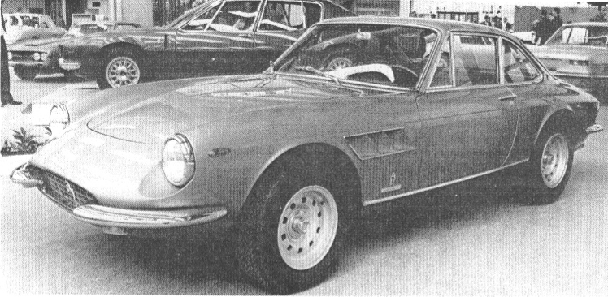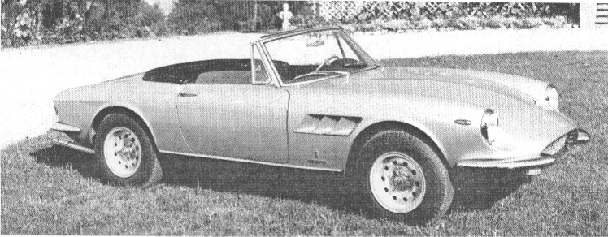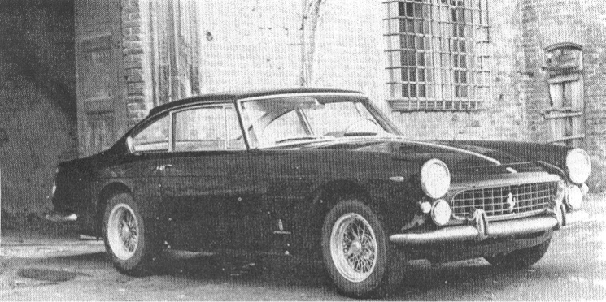 | 330 GT Registry |  |
Volume 18 Number 16
31 July 1993
330 FERRARIS
In the beginning of Ferrari automobiles there was the 125, a 60° V- 12 single overhead cam per bank engine displacing approximately 1.5-liters (or 125 cc per each of its 12 cylinders) whose original design was laid down by Gioacchino Colombo. From the 125 came (in numerical, not necessarily chronological, order) the 159, then the 166 (which established Ferrari’s firm foundation), the 225, the legendary 250 (with inside and outside plug cylinder heads), the 275 and finally the 400 (which was NOT 400 cc per cylinder, but “400 deciliters” in overall displacement). Along the way the details of the basic design were refined. Experiments, successful and unsuccessful, were made. Modifications were made. But as a family, these small-block “Colombo” engines were a continuous part of the Ferrari story for over twenty years.
There were, of course, other lineages of Ferrari engines during those first two decades. There were the large-block “Lampredi” engines, as designed by Aurelio Lampredi. He was also responsible for the short-lived in-line four and six- cylinder engines. There were the Alfredo “Dino” Ferrari inspired and Vittorio Jano designed V-6 and V-8’s. There were experiments with a two-cylinder engine; with super charging; with four overhead camshafts. All-in-all a fascinating variety of engine technology.
In 1963 a new variant of the Colombo V-12 was introduced by Ferrari. This new engine had a new cylinder block. From the smallest 125 (1,500 cc displacement) to the largest 400 (4,000 cc displacement), the Colombo V- 12 engines had shared a 90 mm bore center dimension. This was now increased to 94 mm requiring, obviously, a longer block. For all practical purposes the original block size had reached its displacement limit with the 77 mm bore/71 mm stroke 400 SuperAmerica. These bore/stroke dimensions, when applied to the new block with increased bore centers, resulted in the Ferrari Type 209 engine, better known as the 330 engine for its approximately 330 cc per cylinder.
Dyke Ridgley, writing in the latest issue of Cavallino, states “it can be argued that the 209 engine was the best street motor Ferrari ever built.” He cites the simple (for a Ferrari engine) basic design, ease of maintenance, durability, power output and torque range while its only perceived drawback is its slower throttle response when compared with the shorter stroke (58.8 mm) of the earlier generations of Colombo V-12’s. This engine was rated by the factory to produce 300 horsepower at 6,600 rpm, although Dyke points out that the factory dyno tests usually resulted in 250-260 “real horsepower”.
The Type 209 or Ferrari 330 motor made its debut in late 1963. To be sure there had been a few competition Ferraris in circulation that were given, either officially or unofficially, the “330” designation but their engine had apparently all been based on the shorter 400 SA Type 163 engine, and not on the Type 209.
So the honor of being the fist Ferrari 330 with Type 209 engine falls on the 330 America. This was an “interim” model which quietly slipped into production in late 1963, and just as quietly went out of production before the year ended. It basically was nothing more or less than the 250 GTE 2+2 Series III body and 2600 mm wheelbase powered by the new 4-liter Type 209 engine. Only about 50 examples were built, all in late 1963, in the S/N range from 4953 through 5125.

Ferrari 330 GT 2+2 Series I with Type 209 engine and infamous four headlights. Pininfarina photo.
The next 330 to make an appearance was originally designated simply as the 330 GT but would come to be known as the 330 GT 2+2 to further define it. For this model a new chassis was designed--but one which retained the traditional Ferrari architecture--with a 2,650 mm wheelbase. The running gear was quite similar to its predecessor, with some improvements made to the suspension, brakes and 4-speed plus overdrive gearbox.
Pininfarina clothed this new Ferrari with an all new body design which Antoine Prunet described, in Ferrari, The Road Cars, as having “perhaps lost part of the aggressive and cat-like character typical of Pininfarina Ferraris.” An almost universally criticized feature of the design was the adoption of four headlights. The car was first shown at the annual Ferrari Press Conference in early January, 1964; and unveiled to the public at the Brussels Salon shortly thereafter.
In its basic form this 330 GT 2+2 Series I would remain in production until early 1965. About 500 examples were produced, in the S/N range from 4963 through 6937. In its place came an interim model, still carrying the four head light bodywork but with a new five-speed fully synchronized transmission and other refinements. Approximately 125 of these 330 GT 2+2 Interims would be produced, in the S/N range of 6939 through 7547.
The final 330 GT 2+2 was introduced in late 1965. The styling of the front end was cleaned up, reverting to the more traditional two headlight configuration, and other minor aesthetic adjustments were made. This model would remain in production through 1967 with regular and constant refinements such as a new, improved two-mount engine block; suspended pedals; revised transmission; etc. By the time the last of the estimated 455 examples were being produced (S/N range 7553 through 10193) it had become quite civilized with air conditioning and power windows being available options.

Ferrari 330 GT 2+2 Series II with Type 209 engine was much more attractive. Pininfarina photo.
The next Ferrari 330 was introduced at the Geneva Salon in the Spring of 1966. This was the 330 GTC, a two-place coupe that filled the gap between the family man’s 2+2 and the sporty 275 GTB. It could be described as a mating of the 330 engine with the fully independent 2400 mm wheelbase chassis of the 275, but it actually improved on both. With the 330 GTC Ferrari changed the Type 209 engine block from four to two motor mounts (an improvement that was subsequently adapted to the 330 GT 2+2); and locked the front-mounted engine to the rear-mounted transaxle into a rigid assembly by use of a torque tube driveshaft (an improvement that immediately found its way into the 275 GTB).

Ferrari 330 GTC with Type 209 engine has been universally praised as one of Maranello‘s best.
Gunther Molter photo.
The styling of the Pininfarina bodywork was an amalgam of several previous successful designs--the nose of the 500 SuperFast, the fenders of the 330 GT 2+2 Series II, the rear of the 275 GTS--topped by a new light and airy greenhouse. Over the years this model has received rave reviews, from Fitzgerald and Merritt’s “one of [the] finest all around road Ferraris built,” written in 1968, to Dyke Ridgley’s “the first modern Ferrari,” written in 1993. As with almost every Ferrari model, detail refinements were made throughout its production run, which lasted from 1966 into 1968, with about 600 examples being turned out in the S/N range from 8329 through 11613.
The last of the production 330’s to be introduced was the 330 GTS, basically a convertible version of the 330 GTC and in many ways a continuation of the 275 GTS. Although it was already in production, it was officially introduced at the October, 1966 Paris Salon. Some 100 examples were made, in the S/N range from 8899 to 11713. As hinted at above, each of these types went through numerous evolutionary changes and examples from various production periods can be quite different in detail. But as an indication of changing eras, there were very few true one-off or “speciali” versions built of the 330’s.

Ferrari 330 GTS with Type 209 engine provided open air motoring. Pininfarina photo.

The first Ferrari 330 with Type 209 engine was the 330 America, which externally appeared almost identical with the last version of the 250 GTE 2+2. Pininfarina photo.
ROUSH PUBLICATION, INC. P.O. BOX 870709 STONE MOUNTAIN, GA 30087-0018
© 1993 G. ROUSH
